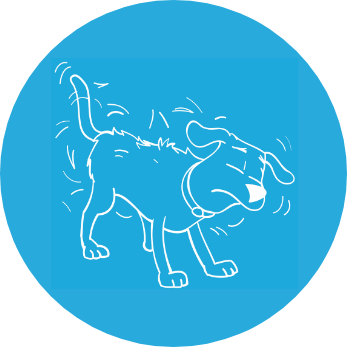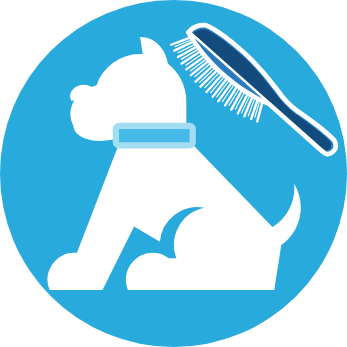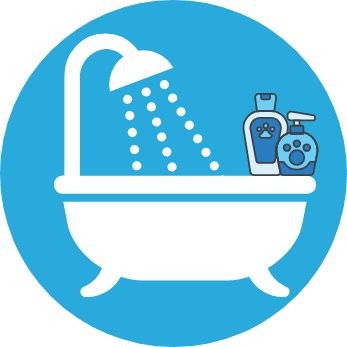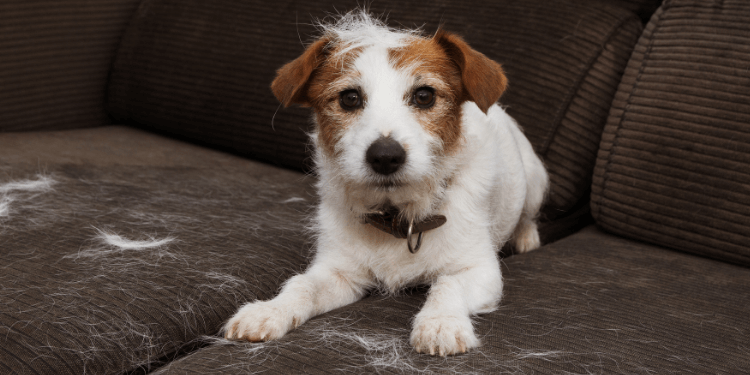First things first, don’t panic. For the most part, dogs shed – it’s what they do. Shedding is a normal process in which your dog’s body naturally removes old or damaged hair. Even shedding that seems excessive (i.e. when the lint roller has become your new best friend) can be normal, depending on your dog’s breed, the weather, and several other factors.
But how much is too much? As a pet parent, it’s important to be able to identify what constitutes abnormal shedding in your dog and to educate yourself on the right steps to take to get your beloved pup healthy again if an underlying medical condition lies at its source.
So if your dog is shedding like crazy, here’s our step-by-step guide to determining when you should be concerned, how to minimize shedding, and how to deal with all that hair!
 Step 1: Understand Normal Shedding
Step 1: Understand Normal Shedding
All dogs shed (except, as you might have guessed, for the American Hairless Terrier). Some breeds shed more than others, and even within breeds, your dog may shed more than another dog of the same breed. The 9 breeds of dog that naturally shed the most are:
- Akitas
- Bernese Mountain Dogs
- Boston Terriers
- Chow Chows
- Corgis
- German Shepherds (aka German Shedders)
- Labrador Retrievers
- Newfoundlands
- Siberian Huskies
In addition to their breed, the weather may be to blame for your dog’s excessive shedding. Many dogs develop thick coats in the colder months of winter that are then shed as temperatures rise in the spring. Cold spells, followed by sudden and extreme warmth can also cause higher than average shedding, as well as long bouts of heat, especially for dogs with thick undercoats.
If you can trace your dog’s excessive shedding to their breed, the time of year, or the weather (and they seem their usual happy, healthy self), there’s likely nothing to worry about. However, if you still feel concerned, there are several ways to identify what constitutes abnormal shedding.
 Step 2: Identify Abnormal Shedding
Step 2: Identify Abnormal Shedding
So what if the weather is mild, and your dog seems to be shedding even more than normal for their breed? If that’s the case, here are several symptoms to keep an eye out for that may indicate an underlying medical condition:
- Skin irritation (redness, bumps, rashes, and/or scabs)
- Bald spots
- Severely thinning coat
- Open sores
- Excessive itching or face rubbing
- Higher than average licking
If you notice any of these symptoms in your dog, especially if they last more than a week, it’s time for a trip to your veterinarian to rule out any medical conditions.
 Step 3: Rule Out Medical Conditions
Step 3: Rule Out Medical Conditions
If your dog exhibits signs of abnormal shedding, your veterinarian can best determine if their excessive hair loss is a symptom of an underlying disorder. Medical conditions that can cause abnormal shedding include:
- Infections (fungal or bacterial)
- Parasites (fleas, lice, or mites)
- Allergies (inhalant, food-related, or topical)
- Kidney, liver, thyroid, or adrenal disease (including Cushing’s Disease)
- Medications
- Cancer
- Immune disease
- Sunburn
- Skin contact with irritating substances
Your veterinarian will be able to determine if one of these medical conditions is contributing to your dog’s abnormal shedding, and will work with you to develop the best course of action to get them back on the path to health.
Know that if your dog is exhibiting signs of a possible underlying medical condition (irritated skin, sores, excessive itching, etc.), it’s important to take them to the veterinarian ASAP. These conditions can be extremely uncomfortable for your pet and can go from bad to worse quickly, so it’s best to start treatment with your veterinarian’s advice as quickly as possible.
 Step 4: Up Your Dog’s Nutrition
Step 4: Up Your Dog’s Nutrition
Excessive shedding can sometimes be prevented through proper nutrition, and your dog’s skin and coat are a direct reflection of the essential nutrients they are or aren’t receiving. While many pet parents and even animal professionals have long believed fish oil and omega 3-fatty acids are the keys to healthy skin and coat, the truth is that omega-3s alone is only one part of a much greater solution.
Optimal skin and coat health require the right ratio of both omega-3 and omega-6 fatty acids (from both marine and plant sources), along with the addition of some key vitamins and minerals essential to your dog’s skin. These can easily be provided to your dog with a high-quality daily supplement.
A key bonus ingredient you may want to explore is methylsulfonylmethane (MSM). This bio-available sulfur naturally supports the structural integrity of your dog’s skin by providing the key sulfur component of collagen and keratin. It also naturally eliminates free radical damage of the skin by supporting glutathione production.
 Step 5: Reduce Stress
Step 5: Reduce Stress
Just like humans, dogs get stressed. And just like in our bodies, emotional responses are powerful and can manifest physically in your dog’s body. If there’s been a big change in your home environment, your dog’s excessive shedding could be a stress reaction. Have you recently moved homes? Has a family member passed away or moved out? Maybe there’s been a higher-than-normal level of conflict in your household? Dogs are sensitive to all these things.
If you suspect your dog may be losing their hair due to stress, do everything you can to provide a normal, predictable daily routine for them. Walk them at the same time each day, avoid switching up their food or mealtimes, and as much as possible, do what they likely expect to be coming next. And of course, give them plenty of TLC around the clock.
 Step 6: Ensure Consistent Brushings
Step 6: Ensure Consistent Brushings
So what to do about the crazy amount of hair floating around your house? One of the best things you can do to curb excessive shedding is to brush your dog regularly. This collects your dog’s old or damaged hair into one convenient spot instead of them spreading it all over the carpet.
Depending on your dog, consistent brushings may mean daily, weekly, or monthly grooming. Keep in mind that certain brushes work better on certain types of coats. For example, bristle brushes are great for dogs with short or wiry coats, pin brushes tend to work well for long and silky-haired dogs, and undercoat rakes are designed to get deep into double and heavy coats. Do your research and shop around before committing to a brush to ensure you get the most bang for your buck.
 Step 7: Bathe Your Dog Regularly
Step 7: Bathe Your Dog Regularly
Another great way to damper excessive shedding is to bathe your dog regularly. This will help rinse off much of the dead and damaged hair that would eventually come off during shedding, significantly reducing the amount of hair floating around your house. For most dogs, a once per month bath is sufficient. If needed, it may help to up this to twice per month during the warmer spring and summer months when natural shedding may increase.
Now that you have a greater understanding of when you should be concerned about your dog’s excessive shedding, it’s in your hands to take the next steps – whether that’s managing it through regular brushing and bathing, upping nutrition and lowering stress, taking your dog to the veterinarian to address underlying medical concerns or all of the above. Your dog (and your upholstery!) will thank you.



 Step 1: Understand Normal Shedding
Step 1: Understand Normal Shedding  Step 2: Identify Abnormal Shedding
Step 2: Identify Abnormal Shedding Step 3: Rule Out Medical Conditions
Step 3: Rule Out Medical Conditions Step 4: Up Your Dog’s Nutrition
Step 4: Up Your Dog’s Nutrition Step 5: Reduce Stress
Step 5: Reduce Stress Step 6: Ensure Consistent Brushings
Step 6: Ensure Consistent Brushings Step 7: Bathe Your Dog Regularly
Step 7: Bathe Your Dog Regularly







